- Anne of Cleves Estate
- Shop at Barrow Green
- Conyer Creek
- Teynham Public HousesNW
- Bishop's Palace, Teynham
- Greestreet Methodist Church
- St Mary's Church
- Barrow Green School
News from the Bell Tower
We will try and unfold some of the mysteries of the language of bell ringing/campanology, the ancient art that is still enjoyed by thousands of people today, with a dictionary of terms
We start with the Bells:-
THE CLAPPER - A metal rod that strikes the bell
DOWN - The position of the bells after ringing.
MUFFLED - A leather pad strapped to cover the clapper.
HALF MUFFLED - A leather pad strapped to one side of the clapper [used for Remembrance Services]
PULL OFF - To start the bell ringing.
SALLY - The tufted hand grip of the bell rope.
TAIL END - The end of the rope which is usually doubled backed on itself.
VOID - The room above the ringing room but below the bell chamber.
WHEEL - This is mounted on the head stock. The rope is placed on the wheel so as to turn the bell over.
HAND STROKE - A pull on the “sally” to turn the bell almost 360 degrees.
BACK STROKE - A pull on this returns the bell to its original position.
TREBLE - The lightest bell of the ring.
TENOR - The heaviest of the ring
Now we deal with the Ringers:-
THE BAND - A group who ring a set of bells at any particular tower.
CONDUCTOR -The ringer calling the bobs and singles in a touch, quarter peal or a full peal i.e. a method is chosen, say Teynham for example, then the conductor calls “Go Teynham” to start the ringing. “That’s all” is called at the end
Hoping that you are keeping up with it, now for the intricacies of the Music.
COMPOSITION - A method.
MINIMUS - A method on 4 bells
DOUBLES- A Method on 5 bells
MINOR - A method on 6 bells.
TRIPLES - A method on 7 bells.
MAJOR - A method on 8 bells
CATERS - A method on 9 bells.
ROYAL - A method on 10 bells.
CINQUES - A method on 11 bells.
MAXIMUS - A method on 12 bells.
A PEAL - A ring of 5000 changes, and takes 3 hours to ring. No visual aids given to the ringers to assist with the peal nor with the quarter peal below.
A QUARTER PEAL - 1260 changes, and takes about three quarters of an hour to ring.
A CHANGE - A ring of the bells once-thus part of a method.
BOB - A certain point in the method.
SINGLE - Another point in the method.
EXTEND -To develop a method for more bells so that, for example, A plain bob minor, becomes a plain bob major.
SPLICED- A part of one method is joined to another method. then another then another so on and so on.
PLAIN COURSE, Ringing a method without bobs and singles.
ROUNDS - Ringing the bells in descending order of pitch.
HAND STROKE & BACK STROKE - Are the two parts of the cycle of movements which takes the bell over 360º and then back again to its normal ringing position.
METHODS - Any person, town, village, county, street, lake, [you name it] can have a method named after it.
This is all good exercise for the body and mind, so why not have a go. We practice Thursday evenings at 8.00 pm. First and third at Teynham church, second and fourth at Lynsted church. Below we cover the bells themselves.
Go to top
Here are details of the six bells that hang in the bell tower of St Mary’s Church, along with a little background information.
Bell 1
Weight: 4cwt 3qrt 9lb (245kg)
Diameter 27¾ inches (705mm)
Date Cast 1743
Founder: Robert Catlin
Bell 2
Weight: 5cwt 0qrt 1lb (254kg)
Diameter 29½ inches (749 mm)
Date Cast 1924
Founder: Mears & Stainbank
Bell 3
Weight: 5cwt 2qrt 10lb (284kg)
Diameter 30½ inches (775 mm)
Date Cast 1743
Founder: Robert Catlin
Bell 4
Weight: 6cwt 0qrt 21lb (314kg)
Diameter 31¾ inches (806mm)
Date Cast 1743
Founder: Robert Catlin
Bell 5
Weight: 6cwt 3qrt 13lb (349kg)
Diameter 34¾ inches (883mm)
Date Cast 1899
Founder: Mears & Stainbank
Bell 6
Weight: 10cwt 3qrt 7lb (540kg)
Diameter 39 inches (891mm)
Date Cast 1743
Founder:S Robert Catlin
A bell’s weight is usually measured in the traditional units of the long hundredweight (cwt), quarters and pounds. A bell weighing ‘4-3-9’ is then 4cwt, 3qtr 9lb, or 245 kg.
Over its half-millennium or more of existence the famous Whitechapel Bell Foundry has operated under several names. More often than not, these have been the name of the bell founder who owned it at that time. The name ‘Whitechapel Bell Foundry Ltd’ did not come into use until the company was incorporated in 1968. Immediately prior to this, ‘Mears & Stainbank’ was one of the names the foundry had traded under.
Robert Catlin was a founder in St. Andrew’s Holborn. The foundry was moved to Longford near West Drayton by Thomas Swain, a minor Middlesex founder, who took over the business in 1739.
Go to top
Inscriptions on the Bells
Bell 1:
(Treble ) = R.C
Bell 2:
MEARS & STAINBANK LONDON 1743
Bell 3:
ROBERT CATLIN 1743
Bell 4:
ROBERT CATLIN CAST AND HUNG US ALL 1743
Bell 5:
(RECAST BY MEARS & STAINBANK LONDON
JAMES EDWARD CORBOULD - VICAR
ROBERT LAKE )
WILLIAM ROPER DIXON) CHURCH WARDENS 1899
Bell 6:
TENOR
THE REVD.JOHN SWINTON - VICAR
ISACC KEMP )
RICHARD HUBBARD ) CHURCH WARDENS
ROBERT CATLIN 1743
Go to top
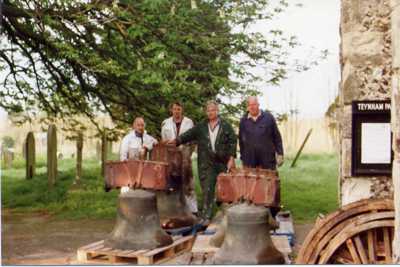
The Bells Working Party
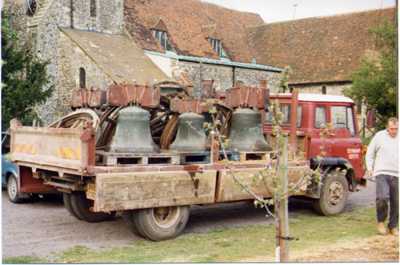 The bells loaded onto the lorry ready to go to the Whitechapel Bell Foundry to be tuned
The bells loaded onto the lorry ready to go to the Whitechapel Bell Foundry to be tuned
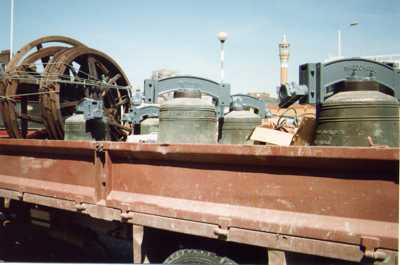
The bells outiside of the Whitechapel Bell Foundry ready to come home. Note the difference.
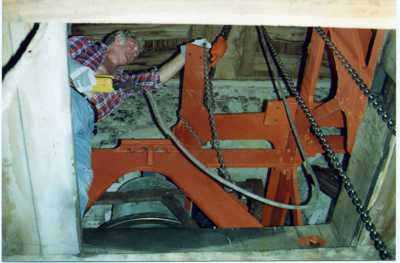
Bryan Tumber replacing part of the frame
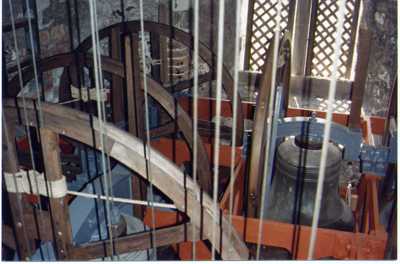 The refurbished bells in place. Note the wires which hild the weights of the clock
The refurbished bells in place. Note the wires which hild the weights of the clock
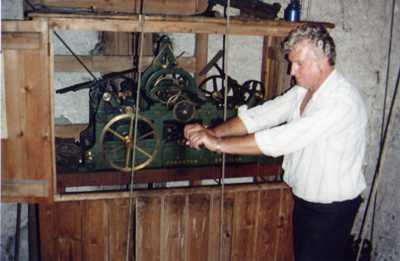
Bryan Tumber winding the clock
The photographs shows the bells loaded onto a lorry ready to go to the Whitechapel Bell Foundry to be tuned. They were then rehung, with mainly new fittings, in the existing bell frame which had been strengthened in 1899 by the Whitechapel Bell Foundry London. Alfred Lawson was the founder at this time whose father was taken as a character model by Charles Dickens when writing ‘Dombey and Son’.
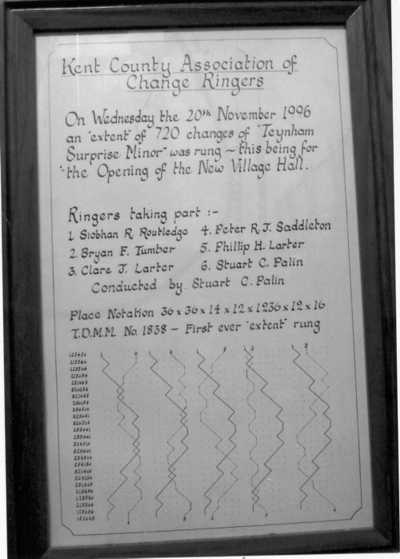 After the bells were rehung, I looked in a ‘Method’ book to find a new method which had never been rung; then got a band of ringers together and learnt the method. Unlike music, these methods are rung with no visual aids, it all has to be committed to memory. On Wednesday 20th November 1996, 720 changes of the method were rung for the opening of the new Teynham Village Hall. I named the method “TEYNHAM SURPRISE MINOR” which is now rung all over the country, making it famous.
After the bells were rehung, I looked in a ‘Method’ book to find a new method which had never been rung; then got a band of ringers together and learnt the method. Unlike music, these methods are rung with no visual aids, it all has to be committed to memory. On Wednesday 20th November 1996, 720 changes of the method were rung for the opening of the new Teynham Village Hall. I named the method “TEYNHAM SURPRISE MINOR” which is now rung all over the country, making it famous.
Records show that 40,320 changes on tower bells have been rung at Loughborough on July 27th 1963 taking 1 day 4 hours to ring by ringers taking shifts. And 40,320 changes of Major have been rung on hand bells at Farnham.
In celebration of the opening of Teynham Village Hall, as mentioned above, and to congratulate the Fundraising Committee on the hardwork that it had put into the project, an extent of 720 changes of ‘Teynham Surprise Minor’ was rung - this being the first ever extent in the method.
The ringers were :-
1 Soibhan R. Routledge (Faversham)
2 Bryan F. Tumber (Teynham)
3 Clare J. Larter (Ospringe)
4 Peter R.J. Saddleton (Herne Hill)
5 Philip R.J. Larter (Ospringe)
6 Stuart C. Palin (Ospringe)
Conducted by Stuart C. Palin.
Place notation 36x36, 14x12x1236x12x16. (TDMM 1838) The maximum number of changes on 6 bells without repeating a change. This is another first in Teynham’s History!
On a sadder note, but in celebration of the life of the late Vernon J. Page, a quarter peel was rung on Friday 12th December 1996, (1260 changes), single Oxford Bob Minor in 39 minutes.
The ringers were:-
1 Eileen S. Palin (Ospringe)
2 Bryan F. Tumber (Teynham)
3 Timothy S. Wraight (Rainham)
4 Derek Chatfield (Ash)
5 Donald H. Niblett (Canterbury)
6 Ian F. Young (Sandwich)
Conducted, by request, by Donald H. Niblett.
First blows in the method 1, 2, and 4. High Officers of the Kent county Association of Change Ringers 3, 5 and 6.
The above method was Vernon’s favourite. He will be sadly missed.
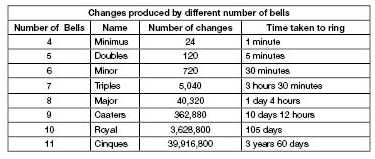
Bryan Tumber Captain of the Ringers
Go to top